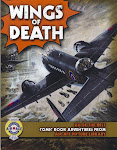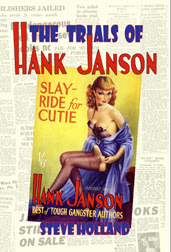 Harry Winslade, sometimes known as Redvers Blake, was born Harry Redvers A. Winslade in Farnham, Surrey, on 1 December 1901, the son of Albert Arthur Winslade and his wife, Isabella (nee Williams), who had married in Farnham in 1898. The Winslade family had roots in Farnham dating back at least a couple of generations, Albert's father, Taplin Winslade, working there as an engine driver. The odd Christian name (Taplin) would appear to derive from the marriage of Stephen Winslade and Harriet Taplin in nearby Crondall, Hampshire, in 1840.
Harry Winslade, sometimes known as Redvers Blake, was born Harry Redvers A. Winslade in Farnham, Surrey, on 1 December 1901, the son of Albert Arthur Winslade and his wife, Isabella (nee Williams), who had married in Farnham in 1898. The Winslade family had roots in Farnham dating back at least a couple of generations, Albert's father, Taplin Winslade, working there as an engine driver. The odd Christian name (Taplin) would appear to derive from the marriage of Stephen Winslade and Harriet Taplin in nearby Crondall, Hampshire, in 1840.Harry second name, Redvers, is rather less exotic than I realised (and shared with another artist, Raymond Redvers Briggs). I imagine the third initial probably stands for Albert or Arthur, after his father.
It would appear that young Harry was raised in Aston, Warwickshire, where his parents were living at the time of the 1911 census. The family may also have spent some time in the Rochford area of Essex, where Harry's father died in 1919.
That same year, Harry and his mother, Isabella, visited Niagara Falls, where Harry's sister, Mrs. E. Hagen, was living. At that time, Harry's occupation was already described as artist. Harry returned from Canada in August 1920, although his mother returned to Canada soon after. In 1925, another trip by Isabella to Canada reveals that her nearest relative in England is her son, whose address is given as c/o J. Haddon & Co., Salisbury Square, Fleet Street. John Haddon & Co. was a printers and booksellers who later became an advertising agency and it seems likely that Harry was on the staff as an artist. (Haddon & Co. were still active until at least the 1970s)
By 1939 he was living at 44 Amberley Gardens, Stoneleigh, Surrey, where he was to live for the remainder of his life. His death was registered at Surrey Mid E. in 1980.
 Joining these dots together to make some sort of coherent life story is almost impossible. However, I was fortunate enough to correspond recently with Pauline Fynn, who remembered Harry Winslade from her days working as an office junior at the Temple Art Agency in Chancery Lane in the early 1960s.
Joining these dots together to make some sort of coherent life story is almost impossible. However, I was fortunate enough to correspond recently with Pauline Fynn, who remembered Harry Winslade from her days working as an office junior at the Temple Art Agency in Chancery Lane in the early 1960s.At the time Temple Art was run by Dan and Pat Kelleher and consisted of two old fashioned, small office rooms with a connecting door between them. The office was on the second floor of the building, opposite Northams, a tailors business.
"As office junior my duties were to open and also to send off the post, act as receptionist, make the tea and collect and deliver parcels, sometimes to or from railway stations such as Kings Cross or Charing Cross," recalls Pauline. "On occasion, I also delivered to the artists homes. I remember delivering some artwork to Peter Jackson in South Kensington and Gerry Embleton, who was in Ilford. I used to know a lot of the artists' addresses by heart because I did the post every day, but I've forgotten most of them now. I remember Stephen Chapman's address in Westcliff on Sea, mainly because I have a book he gave me on 'Horse Anatomy' and his name and address is written inside.
"I didn't have a lot to do in the office. There were only me and my two bosses. I was really there to mind the shop and answer the phone when the Mr. Kellehers were out on their business meetings. I was told I could draw or read while they were out or when I had nothing to do. A cushy job, really! I used to sit and draw a lot. I loved art.
"Harry Winslade used to call in fairly regularly. He would have been about sixty at that time and seemed very old to me. He also taught art at one time and was very good to me, advising me on my drawing. He showed me how to use pen and ink to draw.
"Dan Kelleher treated me very well. I was only fifteen when I went to work there and, after viewing my artwork, he gave me a reference to St. Martin's School of Art. He offered to take me on his books if I completed Art School studies to become an illustrator and advised me to attend evening General Drawing classes, which I did for a year. I didn't carry on with it, though. I left Temple Art in 1963 for another office job with higher pay."
 In 1961, Pauline would spend much of her time drawing. "I used to produce these little poses out of my head and attempt to emulate the comic strip style of pen and ink," she says. When visiting, Harry Winslade would assess her work. "You will see pencil drawings by Harry on the two boards [see above], next to my pen and ink ones, and some blue biro sketches at the sides also by Mr. Winslade [see below]. He encouraged me to try pen and ink and even told me what to buy and where to buy it (Mappin & Webb). The illustration boards were off cuts sent in by the artists as packing for their pictures."
In 1961, Pauline would spend much of her time drawing. "I used to produce these little poses out of my head and attempt to emulate the comic strip style of pen and ink," she says. When visiting, Harry Winslade would assess her work. "You will see pencil drawings by Harry on the two boards [see above], next to my pen and ink ones, and some blue biro sketches at the sides also by Mr. Winslade [see below]. He encouraged me to try pen and ink and even told me what to buy and where to buy it (Mappin & Webb). The illustration boards were off cuts sent in by the artists as packing for their pictures." Harry Winslade's career in comics would seem to begin in 1950 when he began producing illustrations for Eagle. His first illustration appeared in the third issue (in production before the first was even out) and he would supply a number of illustrations between 1950-52, including the illustration that accompanied the Arthur C. Clarke story, "The Fires Within", published under Clarke's pen-name Charles Willis, in August 1950.
Harry Winslade's career in comics would seem to begin in 1950 when he began producing illustrations for Eagle. His first illustration appeared in the third issue (in production before the first was even out) and he would supply a number of illustrations between 1950-52, including the illustration that accompanied the Arthur C. Clarke story, "The Fires Within", published under Clarke's pen-name Charles Willis, in August 1950.Winslade drew "Judy and Pat" for Girl in 1951-52. Over the next few years he drew various features for Eagle, "Don Conquest" for Mickey Mouse Weekly and illustrations for Rocket. In early 1958, he began drawing two strips, "The Brainy B's" for Zip and the "Battle Brothers" for Express Weekly, although it was for the former that he was to draw his longest-running strip. This featured the adventures of explorer Sir Nigel Tawny which began in Zip in 1958, switched to Swift the following year and continued until 1962.
 Winslade was not considered amongst the top flight of artists but found steady work on a number of different papers. In the early 1960s he illustrated the "Danger Man" text stories in Express Weekly, various features in Boys' World and "The Big Shot" in Valiant, before finding a far steadier home in the pages of Hornet, contributing to that paper's very first issue with a feature on "The Youngest V.C.". Winslade drew dozens of strips and covers for Hornet over the next few years. Winslade also contributed to Diana and Wizard in the 1960s and 1970s.
Winslade was not considered amongst the top flight of artists but found steady work on a number of different papers. In the early 1960s he illustrated the "Danger Man" text stories in Express Weekly, various features in Boys' World and "The Big Shot" in Valiant, before finding a far steadier home in the pages of Hornet, contributing to that paper's very first issue with a feature on "The Youngest V.C.". Winslade drew dozens of strips and covers for Hornet over the next few years. Winslade also contributed to Diana and Wizard in the 1960s and 1970s.By then he, too, was in his seventies and well past retirement age. Harry Winslade died at the age of 79.
(* Nigel Tawny / Eagle illustration © IPC Media; "The Diggers Were There" © D. C. Thomson. My thanks to Pauline Fynn for sending copies of her sketches and prompting this bit of digging.)





























































































